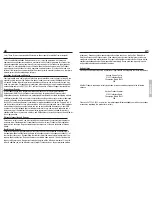
The ignition unit itself should be wrapped in
foam rubber to prevent engine vibration from
damaging the electronic components. All
components must be protected from contact
with engine fuel. Be sure to use an on/off
(Safety or “kill”) switch to allow the ignition to
be turned off and on.
Figure 5
FG-14B/FG-20 Carburetor
iMPOrTanT:
Never turn the engine over with
the ignition turned on unless the spark plug
is inserted in the plug socket. This could lead
to ignition damage.
note:
Saito 4-stroke gasoline engines come
with a pumped carburetor. You do not have
to choke the engine as you normally would a
2-stroke engine.
When you are ready to start the engine, switch
the ignition on and set the throttle to a slightly
high-idle speed. We highly recommend the use
of an electric starter.
Be sure to have a helper hold the model
securely.
Turn on the transmitter first, then the
•
receiver and check the operation of the
throttle servo and other controls.
Turn on power to the ignition system.
•
Using an electric starter, begin cranking
•
the engine. It should fire within seconds
of applying the starter. Allow the engine to
idle for 30 to 45 seconds.
If the engine does not start, even after
•
using the electric starter to crank the
engine a second time, open the throttle
to maximum, turn off the ignition and
turn the engine over about 4 revolutions.
Switch the ignition on again and then
restart the engine with the throttle at a
fast idle position.
If the engine still will not start, unscrew
•
the spark plug and check
its contacts. Clean any possible
excess fuel (an indication of engine
flooding) and screw it in again. Further
starting should only be done with the
throttle at idle position. If the plug is dry,
probably not enough fuel has been drawn
into the carburetor. If that is the case,
check the fuel feed and then return to the
instructions above.
Preparation Before
Starting the Engine
(prior to break-in)
Mount the engine on a strong, flat test
•
bench or on the aircraft. (In either case,
the engine should be secured so it is
immobile.)
Check to make sure the throttle barrel will
•
open and close completely.
Check the wiring of the ignition system to
•
make sure it is connected correctly and
securely.
Make sure the fuel line is connected
•
securely to the carburetor.
For break-in, use a fuel/oil mix ratio of
•
20:1.
FG-14B: Mount a 14 x 6 plastic or wood
•
propeller . Be sure it has been balanced.
(Remember to check the tightness after
every flight.)
FG-20: Mount a 15 x 6 plastic or wood
•
propeller. Be sure it has been balanced.
(Remember to check the tightness after
every flight.)
It is suggested you employ a spinner when
•
using an electric starter. (Remember to
check the tightness after every flight.)
Use a tachometer to prevent over-revving
•
of the engine.
Be sure to connect a gasoline-proof line
•
to the breather nipple to vent oil from the
airframe.
Check the battery of the electric starter to
•
make sure it is fully charged. Be sure to
use a safety on/off switch from the battery
to the ignition.
Warning:
Do not let people stand in
front of or to the side of the engine while
attempting to start it to avoid serious injury.
Also, make sure the engine test bench or
aircraft is completely secure from movement.
Starting the Engine
(assuming the engine is mounted in an
aircraft)
The carburetor on the Saito engine comes
with the low-speed needle adjusted to a basic
setting. The high-speed needle will need to
be set by the user. The standard carburetor
settings are as follows: The high-speed needle
valve is set open counterclockwise from the
fully closed position. The low-speed or idle
needle valve is set clockwise in from flush
from the throttle arm face(reference line).
Please refer to the diagrams.
note:
The minutes listed are in reference to
the minute hand of a clock.
FG-14B
FG-20
High-speed
Needle
1 turn
20 minutes
1 turn
30 minutes
Low-speed
Needle
5 turns
4 turns
20 minutes
Before you first start the engine, make sure
the spark plug is screwed in and tightened,
and that the plug socket cap is fitted in place
and fastened down properly. Fix the ignition
sensor in the proper position at the bottom
of the engine crankcase. The throttle servo
should be mounted at a distance of 8 to 12
inches from the engine. The spark plug cable
must not touch any part of the model structure
as vibration may damage the shielded cable.
If this is not practical, it will be necessary to
provide an insulation material for the cable.
10
F G - 1 4 B / F G - 2 0 B E F O R E S T A R T I N G T H E E N G I N E
F G - 1 4 B / F G - 2 0 S T A R T I N G T H E E N G I N E
11







































